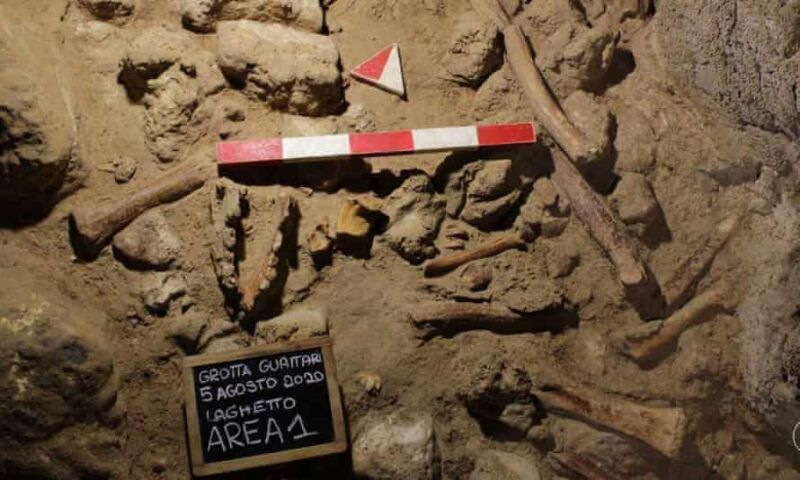
Archaeologists in Italy recently unearthed the remains of at least nine Neanderthals in Guattari Cave, near the Tyrrhenian Sea about 100 km southeast of Rome. While excavating a previously unexplored section of the cave, archaeologists from the Archaeological Superintendency of Latina and the University of Tor Vergata recently unearthed broken skulls, jawbones, teeth, and pieces of several other bones, which they say represent at least nine Neanderthals. That brings the cave’s total to at least 10; anthropologist Alberto Carlo Blanc found a Neanderthal skull in another chamber in 1939.
Italy was a very different place 60,000 years ago. Hyenas, along with other Pleistocene carnivores, stalked rhinoceroses, wild horses (an extinct wild bovine called aurochs), and people.
“Neanderthals were prey for these animals. Hyenas hunted them, especially the most vulnerable, like sick or elderly individuals,” Tor Vergata University archaeologist Mario Rolfo told The Guardian. The archaeologists found the Neanderthal remains mingled with the bones of rhinos, giant deer, wild horses, and other hyenas. Predators and scavengers tend to leave behind different parts of the skeleton than, say, flowing water or simple burial—and tooth marks are usually a dead giveaway.
Sharing is caring
Based on the excavation, hyenas had lived in the cave off and on for thousands of years—maybe alternating with Neanderthals at different times. And during all that time, they seem to have periodically dragged an unlucky Neanderthal back to a den in the cave, where the bones of other long-dead victims lay, already buried under layers of cave-floor sediment.
Most of the newly discovered Neanderthals lived between 50,000 and 68,000 years ago, but at least one dates back to between 90,000 and 100,000 years old. The span of time between the oldest Neanderthal in Guattari Cave and the youngest is nearly as much as the one between now and when the last Neanderthals walked the Earth.
That makes the plan to sequence ancient DNA from the newly discovered remains especially interesting. Researchers are starting to piece together the large, complicated story of how different groups of Neanderthals moved around and interacted with each other during the 300,000 years or so when they alone ruled western Eurasia. But so far, we’ve gotten only glimpses.
Denisova Cave in Siberia is the only place so far where paleoanthropologists have sequenced DNA from Neanderthals who lived at different times; the rest of the story relies on bits of information from a scattering of different times and places. The genomes of nine Neanderthals who lived in the same place over tens of thousands of years could tell a much more detailed story about at least one part of our extinct cousins’ long history. They would also nearly double the number of Neanderthal genomes that have been sequenced so far.
Of course, that assumes that all of the Guattari Cave Neanderthals have ancient DNA that is still in good enough condition to sequence. It will take a lot of work in the lab before we know.
https://arstechnica.com/?p=1763816

